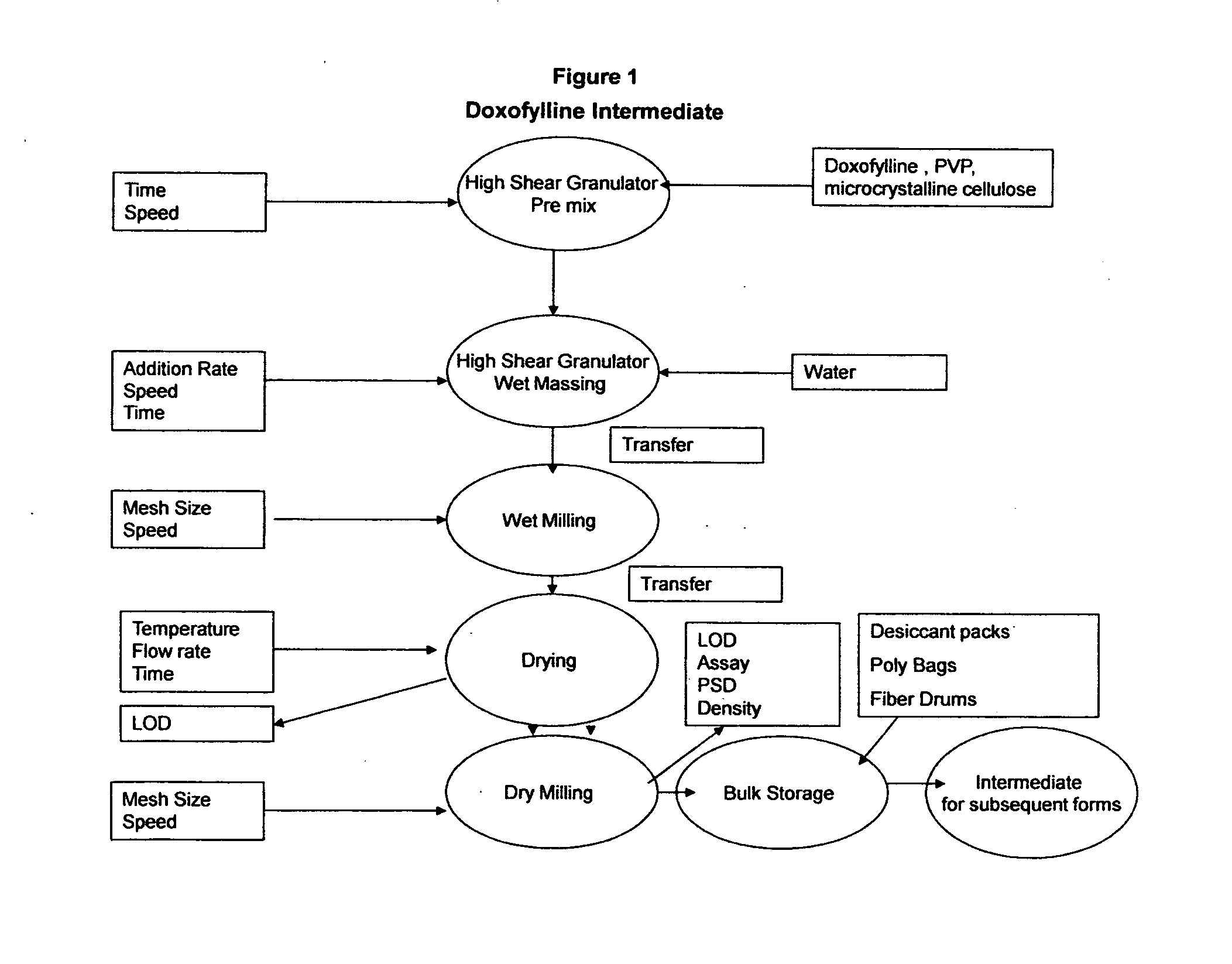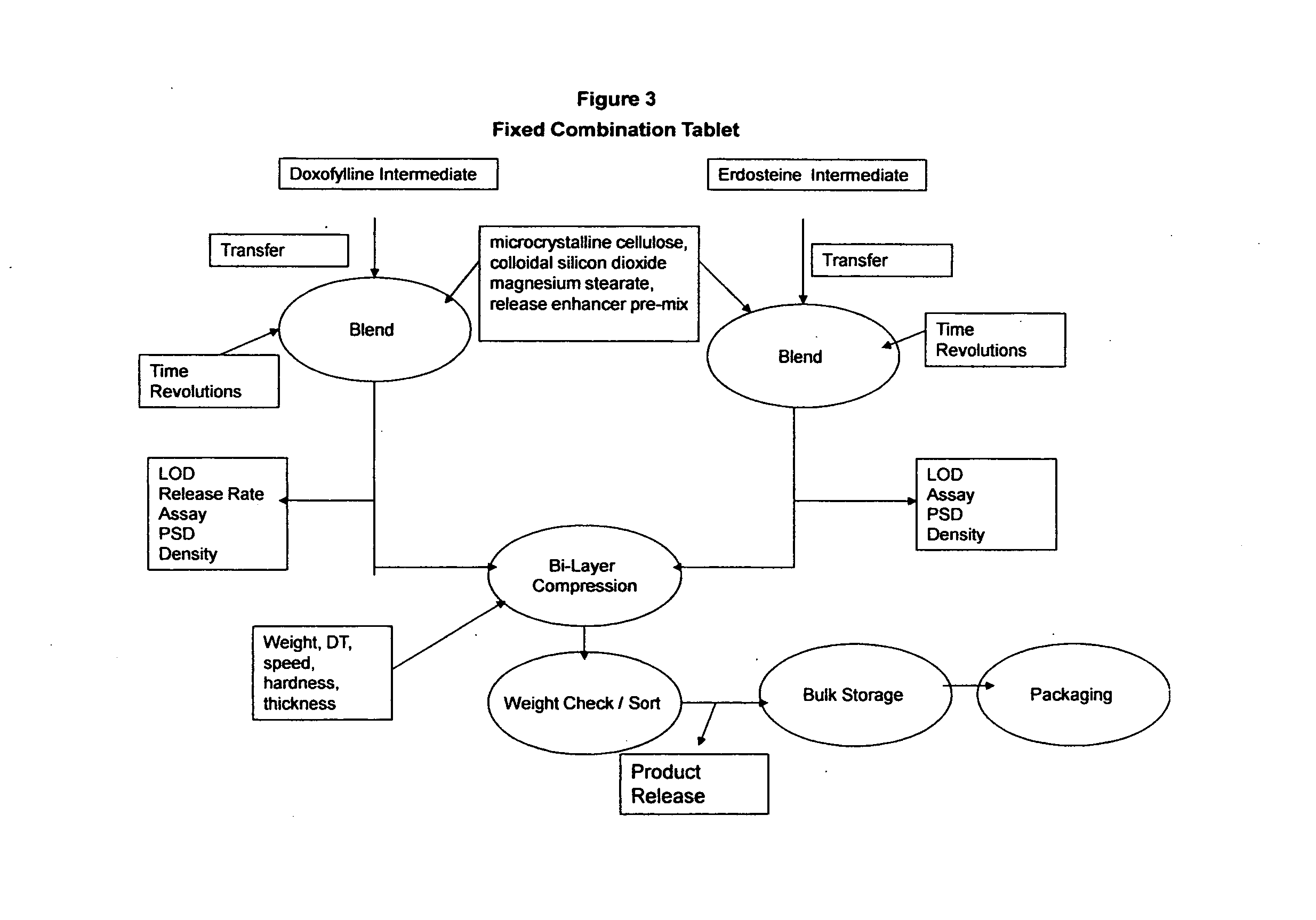Treating Bronchiectasis With Doxofylline and Erdosteine
a technology of erdosteine and doxofylline, which is applied in the field of treating bronchiectasis with doxofylline and erdosteine, can solve the most deleterious symptoms, the most deleterious is the significant impairment of breathing, and the most deleterious is the most deleterious symptom of theophylline treatment, so as to improve the effect of pct alone and achieve significant and clinically meaningful changes in
- Summary
- Abstract
- Description
- Claims
- Application Information
AI Technical Summary
Benefits of technology
Problems solved by technology
Method used
Image
Examples
example 1
[0076]In a double blind study, patients suffering from bronchiectisis are alternatively treated with either doxofylline alone, with erdosteine alone, with the inventive drug composition comprising doxofylline and erdosteine, or with a placebo. One or more objective measures of lung function such as FEV1 and FVC. FEV1, FVC, PEF, MIP, MEP, PaO2 and PaCO2 are significantly improved with the inventive drug composition over results with either drug alone.
[0077]Each of the pharmaceutical compositions of the examples below is useful for simultaneous oral administration of doxofylline and erdosteine
example 2
IR Dosage Form
[0078]
doxofylline and erdosteine400 mg / 300 mgMicrocrystalline cellulose200mgModified Starch 1500200mgMagnesium Stearate8mgEmpty Capsule Shell #096mgTotal Dosage Form Weight904mg
[0079]The immediate release capsules are manufactured using a standard wet granulation technique. Doxofylline and erdosteine, microcrystalline cellulose and modified starch 1500 are dry blended in a suitable mixer such as a planetary mixer. Water USP is then added to the dry powder blend while mixing until suitable granules are formed. The wet mass is dried to a level of approximately 1.5% loss on drying (LOD). The dried granules are then screened / milled to a suitable particle size, blended with the magnesium stearate and subsequently filled into hard gelatin capsules having a final filled weight of 904 mg. The dried blend may be tested for assay and content uniformity prior to the encapsulation. The process is shown in FIGS. 1, 2 and 3 below.
example 3
IR Dosage Form
Compressed Tablet
[0080]
doxofylline and erdosteine400 mg / 300 mgMicrocrystalline cellulose200mgPolyplasdone XL20mgHPMC 3cps25mgAnhydrous Lactose200mgMagnesium stearate6mgColloidal Silicon Dioxide6mgTotal Dosage Form Weight857mg
[0081]The immediate release tablets are manufactured using a standard wet granulation technique. The doxofylline and erdosteine, microcrystalline cellulose, Polyplasdone XL, and anhydrous lactose are dry blended in a suitable mixer such as a planetary mixer. The HPMC 3 cps is added to a sufficient amount of water USP to form a suspension / solution. This is then added to the dry powder blend while mixing until suitable granules are formed. The wet mass is dried to a level of approximately 1.5% loss on drying (LOD). The dried granules are then screened / milled to a suitable particle size, blended with the magnesium stearate and colloidal silicon dioxide and subsequently compressed into tablets having a final weight of 857 mg. The dried blend may be tes...
PUM
| Property | Measurement | Unit |
|---|---|---|
| Mass | aaaaa | aaaaa |
| Mass | aaaaa | aaaaa |
| Weight | aaaaa | aaaaa |
Abstract
Description
Claims
Application Information
 Login to View More
Login to View More - R&D
- Intellectual Property
- Life Sciences
- Materials
- Tech Scout
- Unparalleled Data Quality
- Higher Quality Content
- 60% Fewer Hallucinations
Browse by: Latest US Patents, China's latest patents, Technical Efficacy Thesaurus, Application Domain, Technology Topic, Popular Technical Reports.
© 2025 PatSnap. All rights reserved.Legal|Privacy policy|Modern Slavery Act Transparency Statement|Sitemap|About US| Contact US: help@patsnap.com



